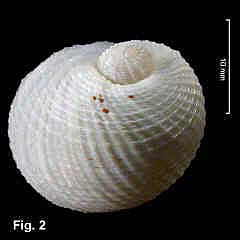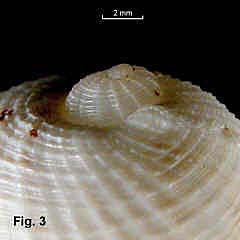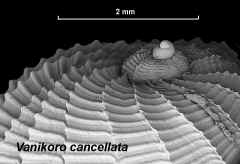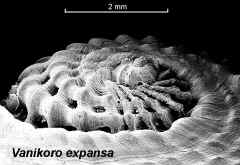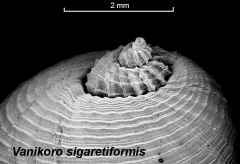|
|
|
|
|
Vanikoro cancellata (Lamarck, 1822) Description: Shell light in weight, spire elevated. Protoconch initially smooth, then with 5 spiral threads. Teleoconch initially with curved axial ribs crossed by about 10 spiral cords; 3-4 threads developing between cords. Axial ribs broaden to low, axial folds on last whorl, often irregularly spaced; primary cords and threads persist producing cancellate surface. Aperture wide; outer lip semicircular, smooth; inner lip of aperture smooth. Umbilicus almost closed. Colour white. Periostracum thin, brown, with fine axial lamellae on the axial ribs. Size: Up to 25 mm high. Distribution: Indo-West Pacific. In Australia, south-western WA around the northern coast to Port Stephens, NSW. Habitat: Intertidal, and probably shallow subtidal, under rocks. Common in the tropics, uncommon in NSW. Comparison: Spire details of the three Vanikoro species are shown below, to the same scale. V. cancellata commences with oblique axial ribs, and numerous spiral cords at about one-third the spacing of the axials. V. expansa commences with strong, oblique lamellae and suddenly adds strong spiral ribs, forming a fenestrate sculpture with deep pits, which remains visible even in very worn shells. V. sigaretiformis commences with strong, oblique lamellae similar to V. expansa, but does not go on to develop the strong fenestrate pattern. Synonymy: The name Vanikoro cancellata (Lamarck, 1822) is used with some hesitancy for this species, but is retained in the absence of good alternative information. This is probably the same as the species described as Vanikoro helicoidea (Le Guillou, 1842) by Cernohorsky (1978). Remarks: This has a delicately sculptured spire, somewhat resembling a spider's web. The sculpture changes slowly from the crisp sculpture on the spire to being finely cancellate on the last whorl. Living shells are covered with a brown periostracum, usually absent in beach washup shells. The anatomy of this species is described by Simone (2002). Fig. 1: 3979-1 Port Stephens, NSW (C.358931) Fig. 2: 3980-1 Same specimen as Fig. 1 Fig. 3: 3981-1 Detail of spire. Same specimen as Figs. 1 & 2. Page History: Comparison images added Aug. 2009 |

